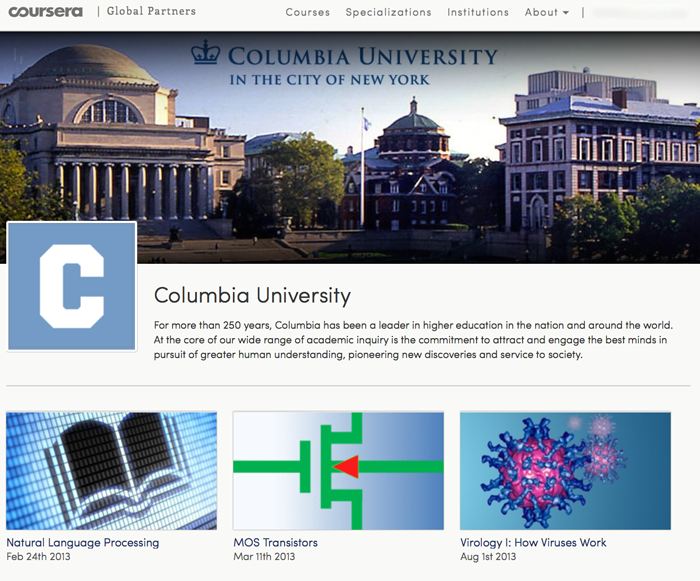On November 5, 2012, Columbia University and Coursera signed an agreement to deliver massive open online courses (MOOCs) to the world. The first Columbia MOOCs launched in February 2013, and by calendar year’s end, Columbia had released and completed eight courses on the Coursera platform.
Michael Cennamo, an educational technology at the Columbia Center for New Media Teaching and Learning (CCNMTL), compiled and analyzed statistics from those eight 2013 courses. The resulting report, "The First Year of MOOCs at Columbia University: 2013," is available to download as a PDF. Below are some of the conclusions Cennamo was able to derive from the data.
 Columbia University on Coursera
Columbia University on Coursera
The “typical’ Columbia MOOC student does not exist.
There does not seem to be only one reason to take a MOOC, or one type of MOOC participant. Our statistics show that a high percentage of students enroll in Columbia MOOCs yet have no substantial engagement within them (“Browsers”). Statistics also show, however, that a sizeable percentage of students return to the course at the start of the second week (“Samplers”) and stay involved for various periods of time. Statistics also indicate that there are numerous students who are active all the way up the last week (”Auditors”), yet do not partake in the requirements for certification. Finally, a small percentage of students do stay active throughout the entire course and participate in all of the activities required for a certificate of completion (“SoA Earners”).
Perhaps success criteria for these MOOCs should be determined by more than certificate earnings numbers alone. There seem to be many types of students enrolled in online courses for myriad reasons.
Video lectures are a vital part of the MOOC experience.
Video lectures are a popular part of the Coursera experience, with millions of views and downloads throughout the length of the course. Coursera MOOCs are allowing Columbia faculty to take their course content on a kind of “global test drive,” in that they provide an opportunity for them to create different types of video lectures and receive extensive feedback on them from the thousands of students inside and outside the University who are watching, analyzing, and subsequently commenting on them.
Evidence of faculty improving video lectures through MOOC student feedback is found, for example, in Virology 1; the posts from students in the discussion forums prompted Professor Vincent Racaniello to add more annotations to several of his lecture videos, as students were not sure what part of the diagram, slide, or chart was being discussed. These improved video lectures have now been incorporated back into his Columbia classroom.
There is a relationship between MOOCs and the “flipped classroom” model.
The Coursera MOOCs have allowed both teachers and staff to see the power of digitizing and distributing lecture materials in order to free up time for other activities. Several faculty have begun experimenting with “flipping” their Columbia courses; providing lecture videos prior to class, and then using class time for deeper exploration of lecture material, problem-based learning, group work, and discussion.
One instructor, Perry Mehrling, ran his Barnard Economics course concurrent with his Coursera course. His Columbia students were expected to enroll in the MOOC and watch the video lectures in the MOOC before class; class time was then spent discussing the video lectures and looking at the material more deeply.
MOOCs can build communities.
Coursera’s discussion forums have shown that strong communities can form in the MOOCs through the exchange of ideas, opinions, and perspectives. Enrollees, with a wide array of knowledge and expertise, assisted in the forums along with faculty, TAs, and staff. Based on the observations of these forum interactions, CCNMTL has become better able to help other faculty use online discussion in more effective ways.

 NEWS FEED
NEWS FEED